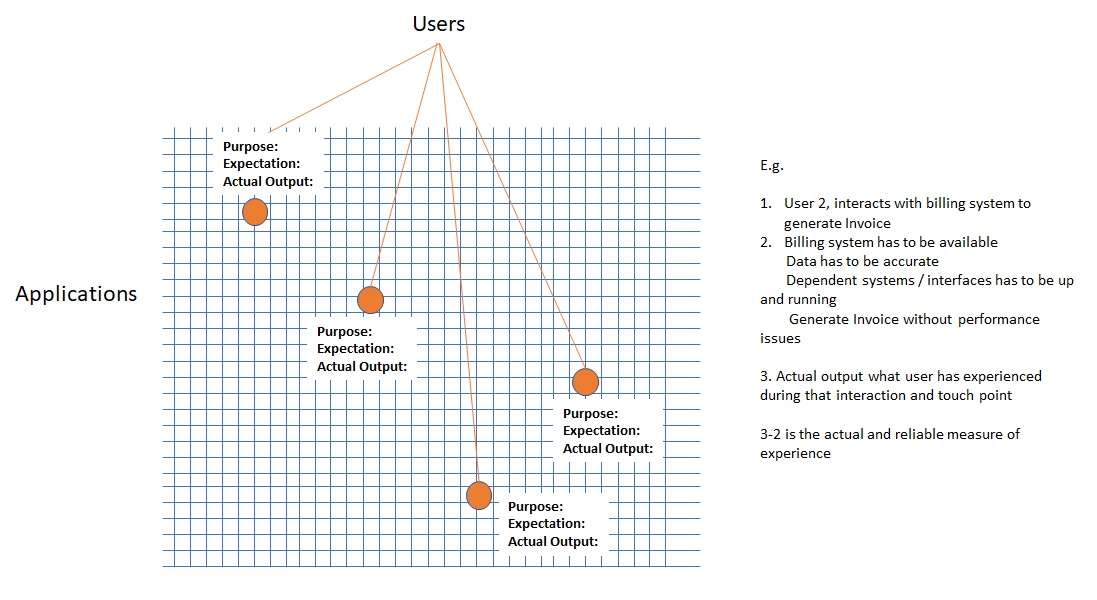Customer Experience Management – CEM has been a prevailing buzzword in the IT services industry for a decade or so. Organizations are investing in various CEM programs to deliver better customer experiences. Service providers, in common, leverage manual survey programs and build NPS and CSAT metrics on understanding or measuring customer experiences. The problem with surveys is its nature of inherent biased responses. Some appear forced, and some provide honest opinion. Moreover industry is lagging today interms of utilizing this feedback. As CEM discipline matures in market, organizations need to think about an holistic customer experience platform which is more matured, driven by data and powered by technology. CEM cannot be isolated from the organization’s DNA. At a broad level, a CEM program must always have users / customers / consumers at its center considering their end-to-end journey and touch points with the business and / or applications as the basis for measuring user experience. While CEM is a broad concept, in this blog, we try contextualizing it to IT services by diving deep into following:
- What is delivering exceptional customer experiences in the context of IT support and maintenance?
- Why does CEM have to be seen as an organizational discipline and not limited to surveys or other feedback processes that are manual?
- Is CEM a one-time activity or a continuous practice across organization?
Framework Conceptualization:
Experience is “An event or occurrence which leaves an impression on someone.” It is a derived parameter from the outcome of the events the user interacts with for achieving their objectives. Though the goal is achieved, it is essential to note that it does not necessarily leave a good impression on users. E.g., You take a flight from A to B for 2 hours. But you finally reach B after a delay of X hrs. Also, sometimes users do not take note of every task performed and move on to a new one. Hence experiences are influenced by many technical, functional, psychological, and demographical data points. A user’s experience of an event must be derived from these data points systematically.
In IT support services, particularly in large contracts, a service provider agrees on specific critical parameters like system availability, accessibility, etc., with the customer and delivers the services in line with those contractual commitments. These parameters are technical, and commitments can be achieved through better design of the systems, processes, collaboration of the teams, etc. But what if the service provider promises that all the users will always be happy by consuming our IT services. Here, we are talking about delivering a good impression; in the former case, we are committing a value to a contractual parameter. Providing an excellent impression to all the users is a derived parameter from various metrics and benchmark values. How do we get to know if the users are happy or not after delivering our services with superior quality and exclusivity? We need to understand what has been the user journey, what were the expectations, what is the reality, and what impression was delivered at that touch point.
Experience measurement
In the following picture, we have users on one side and applications on the other side. There are several transactions between users and applications, which are represented by the mesh. Each line in the mesh is a unique transaction initiated by the user with one or more applications. When users start interacting with the applications, they wish to fulfill specific tasks. The users’ expectations will be the availability of application(s), break-free application(s), data availability, error-free connections, and on-time completion. Users’ preferences also include rich UI, ease of use, high application performance, etc. If these are the expectations, two possibilities can happen in real-time: the happy path scenario and the other where some issues may have been encountered while using the application. The latter case creates a negative impression on the user. But sometimes, it is also hard to say that a transaction has left a good impression on the user in the happy path scenario.
In case of a mismatch between user expectations with applications and the actual behavior, incidents will flow in. This is the starting point of support and maintenance of applications. As a service provider, we focus on fulfilling the contractual terms. But ideally, to improve the users’ experience, we must inculcate the responsibility of minimizing the differences between users’ expectations about what an application can/will do vs. what it does for the user. This is where the concept of moving towards zero maintenance comes up.

Designing Experience Measurement system:
The next question is how to minimize the gap between user expectations vs. application performance. The most trusted way is to rely on the data from multiple sources (e.g., tickets, testing benchmarking metrics, application metadata, user profiles, etc.) and process it across various dimensions (e.g., application types, user roles, geographies, etc.) The creation of such matrices will create immense value, specifically from the application support and maintenance perspective. This will call for a proactive approach to solving unrealized problems and problems that can potentially occur in the future. Once such resolution takes place, it is crucial to add the same as a data source so that fixes can be packaged and delivered automatically. This cycle must continue over time, and the results must be analyzed. It is not a one-time activity. As these cycles mature over time, we can create specific metrics to extract the users’ experience. For example, 99.9% of users have no issues with the IT applications they interact with. Will this create a real-time impact on users and enrich their experience while performing the transaction? Theatrically yes, but the system must be allowed to mature by running multiple cycles.
Among the most common myths prevailing is that applications are responsible for delivering great user experiences. But the reality is that applications must be enabled/empowered by external sources (another application or human) to analyze and extract the user experiences. It is because applications developed as a solution for a specific purpose do not work as a solution to measure or analyze user experiences. Hence, as a service provider, we need to create a technology platform responsible for enabling applications to deliver good user experiences. This platform should be powered by analytics, intelligent technologies, and data management capabilities. Apart from investing in building a technology platform, an opportunity to engage with customers opens. Wondering why? In the earlier section, we discussed collecting different sources like quality benchmarks, application metadata, etc. If there is no systematic experience measurement process, why would other departments/ teams create such metrics? They think from a business-as-usual dimension and achieve their SLAs. Every department will need to be educated on this concept and co-create necessary processes and improvements. It is vital at the org level to align with this concept and allow the change to happen. CEM subject matter experts should be built within the teams to drive these initiatives.
Conclusion:
With our CEM platform, we can start delivering experience metrics from day one (1) and fine-tune them as we mature and gain more profound expertise. The challenging process is to know how we can deliver a good user experience, derive the experience metrics, and then assure or guarantee the same to the customer. At times, personalized metrics can evolve for each customer based on data analysis, and few experience metrics can be realized over a period for some engagements.
The key takeaway is that experience measurement is neither a direct measure nor a one-time activity. It needs a separate org-level discipline and must be enabled by a technology platform to create metrics and deliver a personalized experience to the users. In this blog, we tried to touch up on the basics of the CEM platform and a high-level approach to create a framework for experience measurement. We shall be sharing more insights and use-cases of the CEM platform in subsequent blogs. Stay tuned!!



